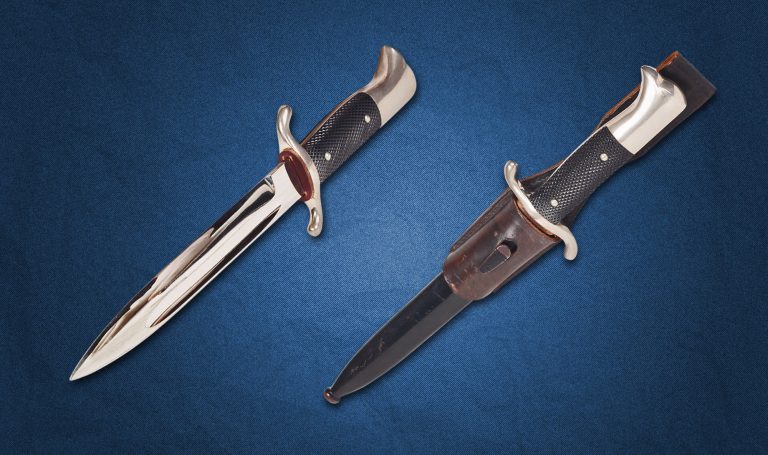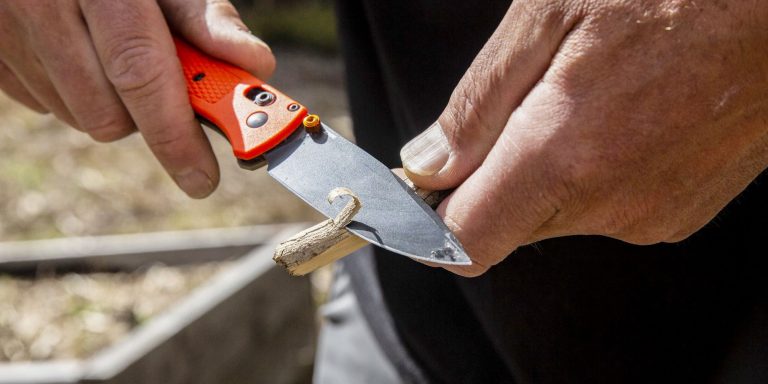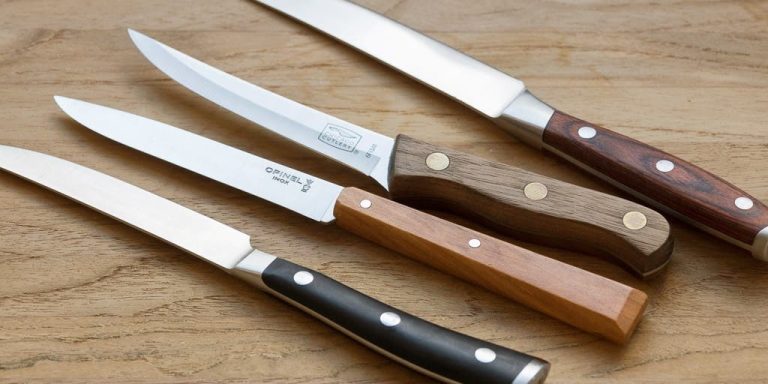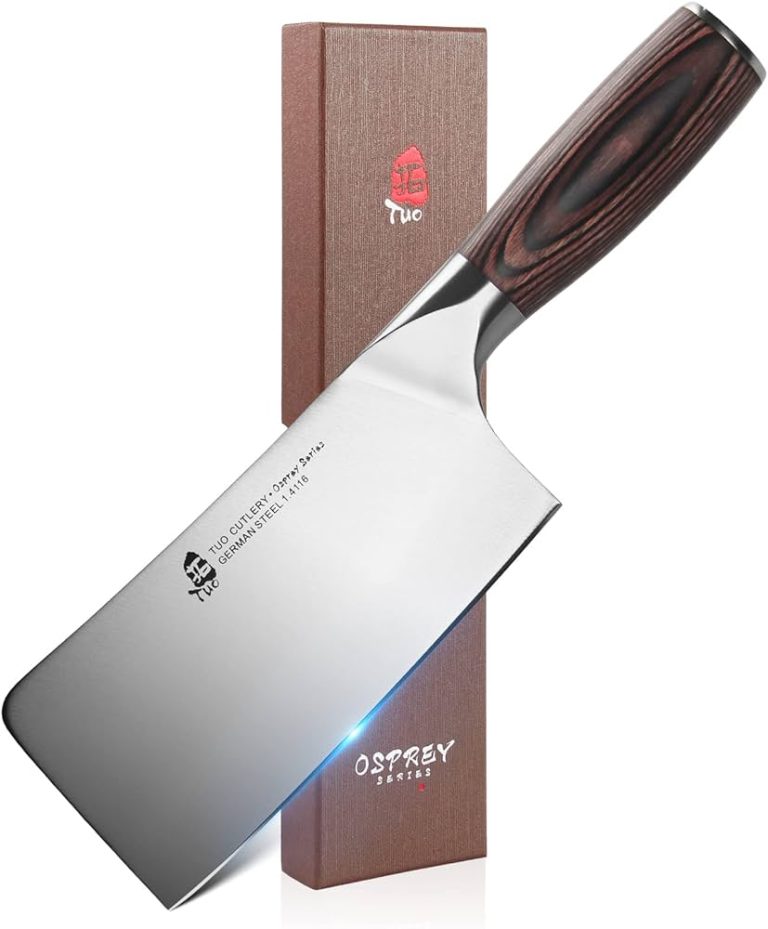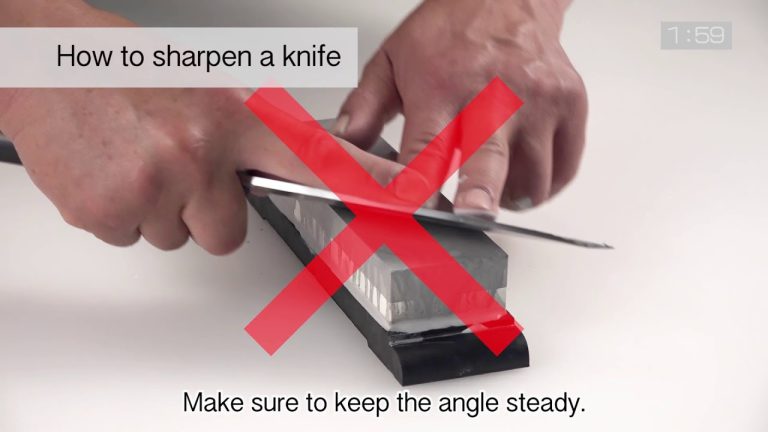A Guide to Essential Kitchen Knives for Home Cooks
A guide to essential kitchen knives for home cooks: Get the right knives for perfect cooking at home. Introducing a variety of essential kitchen knives can take your cooking skills to the next level.
Whether you’re a novice or an experienced home cook, having the right set of knives is crucial for efficient and precise meal preparation. As there are numerous types of kitchen knives available in the market, it can be overwhelming to choose the best ones for your needs.
However, by understanding the specific uses of each knife and considering factors like blade material and handle design, you can select the perfect set that caters to your cooking style. In this guide, we will explore the essential kitchen knives that every home cook should consider adding to their collection. So, let’s delve into the fascinating world of knives and discover the tools that will elevate your culinary experience.
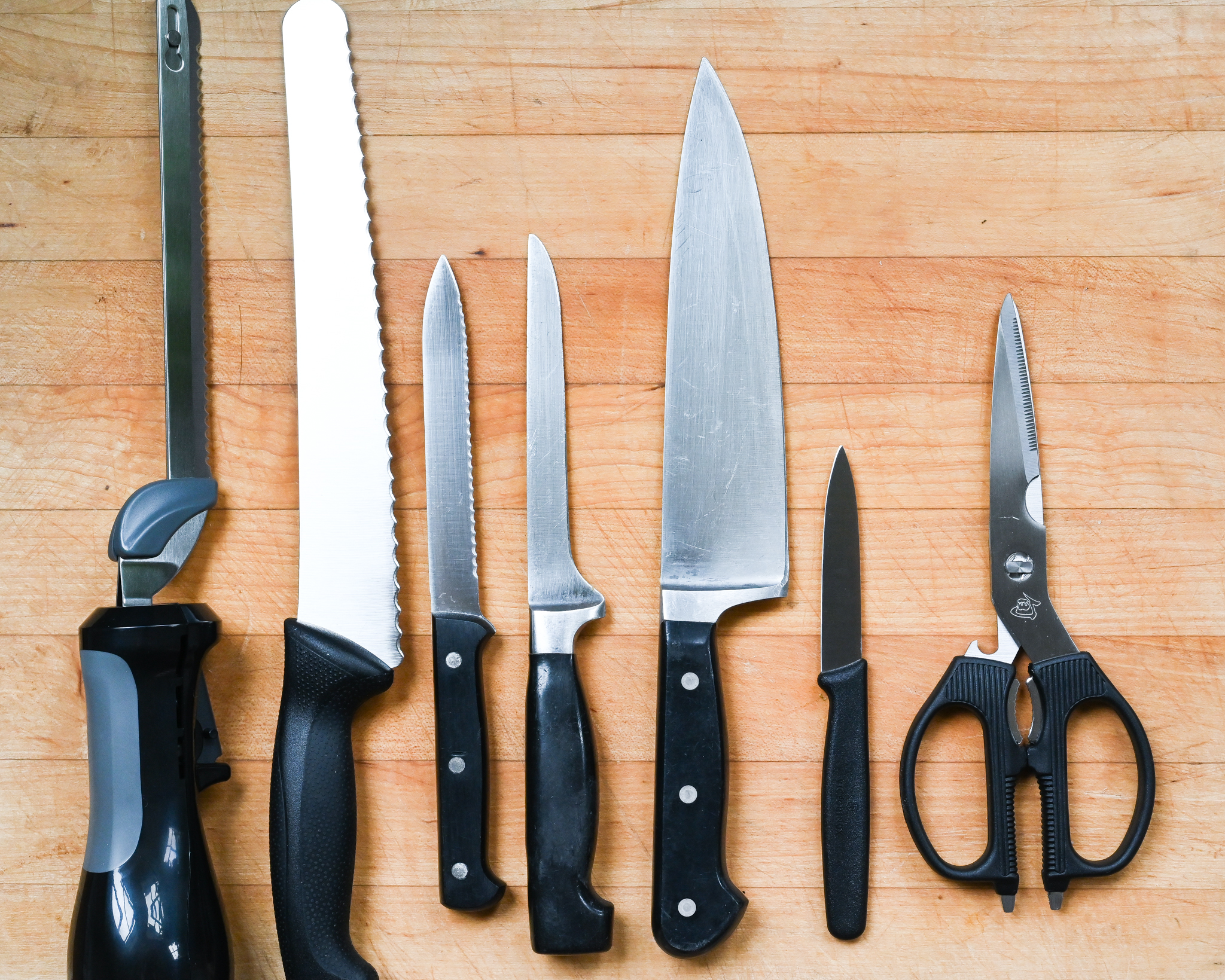
Credit: www.onceuponachef.com
Understanding The Different Types Of Kitchen Knives
Discover the essential kitchen knives every home cook needs to have in their arsenal. From the versatile chef’s knife to the handy paring knife, this guide will help you understand the different types of kitchen knives and their uses.
Chef’S Knife
The chef’s knife is an essential tool in every kitchen. It is versatile and can be used for a wide range of tasks. Here are some key points about the chef’s knife:
- The blade of a chef’s knife is typically between 6 and 10 inches long, with a sharp edge that tapers to a point.
- This knife is perfect for chopping, slicing, and dicing vegetables, fruits, and herbs.
- Its wide blade allows for easy scooping and transferring of ingredients from the cutting board to the pot or pan.
- The curved belly of the chef’s knife is useful for rocking motions when mincing garlic or herbs.
- It is a go-to knife for professional chefs and home cooks alike due to its versatility and efficiency in the kitchen.
Paring Knife
A paring knife is a small, versatile knife that is ideal for delicate tasks. Here’s what you need to know about the paring knife:
- Paring knives typically have a blade length of 3 to 4 inches, making them perfect for intricate work.
- This knife is excellent for tasks such as peeling fruits and vegetables, trimming fat, and deveining shrimp.
- It provides precision and control, allowing you to make detailed cuts with ease.
- The compact size of the paring knife makes it handy for small hands and precise maneuvering.
- It is an essential tool for any cook who values precision and attention to detail.
Santoku Knife
The Santoku knife is a Japanese knife that has gained popularity in recent years. Here are the key features of the Santoku knife:
- The word “Santoku” means “three virtues” in Japanese, referring to its versatility in slicing, dicing, and mincing.
- It typically has a shorter, wider blade compared to a chef’s knife, usually around 5 to 7 inches long.
- The Santoku knife is known for its hollow edges, which reduce the sticking of sliced food to the blade.
- Its straighter cutting edge makes it excellent for precise slices and straight cuts.
- The Santoku knife is a favorite among those who appreciate the precision and finesse of Japanese cutlery.
Bread Knife
A bread knife is a must-have tool for any home cook who enjoys baking or slicing bread. Here’s what you need to know about the bread knife:
- The bread knife has a long, serrated blade that makes it easy to slice through crusty bread without crushing it.
- Its serrated edge allows for effortless cutting through tough exteriors, while the length enables smooth, even slices.
- The serrations grip the bread’s surface, providing stability and preventing it from slipping while cutting.
- In addition to bread, this knife is useful for slicing cakes, tomatoes, and other delicate items with ease.
- A bread knife is an essential tool for achieving professional-quality slices of bread at home.
Remember, a well-equipped kitchen should have these essential knives: the versatile chef’s knife, the precise paring knife, the versatile Santoku knife, and the bread knife for perfect slices. Choose the right knife based on your cooking needs and enjoy the ease and efficiency it brings to your culinary adventures.
Essential Features For Home Cooks
Discover the must-have kitchen knives for home cooks. This comprehensive guide showcases the essential features needed to create culinary masterpieces.
Every home cook understands the importance of having a set of essential kitchen knives. But what features should you look for when selecting the perfect knives for your culinary adventures? In this section, we will discuss the key elements to consider: blade material and construction, handle design and comfort, as well as balance and weight.
Blade Material And Construction
When it comes to kitchen knives, the blade material and construction play a vital role in their performance and durability. Here are the essential features to keep in mind:
- Stainless Steel: Opt for knives with blades made from high-quality stainless steel, as they are resistant to rust and corrosion. Look for varieties labeled as “high carbon stainless steel” for optimal sharpness and strength.
- Blade Thickness: Thicker blades are ideal for heavy-duty tasks like cutting through bones or hard ingredients. Thinner blades, on the other hand, offer precision and are perfect for delicate tasks such as slicing vegetables or filleting fish.
- Blade Shape: Different blade shapes serve various purposes. Santoku knives, with their wider blade and curved edge, excel at slicing, dicing, and chopping. A chef’s knife, with its broader, tapered blade, is versatile and suitable for almost any kitchen task.
- Full Tang: A full tang blade extends the entire length of the knife, providing strength and stability. Look for knives with full tang construction for enhanced control and balance.
Handle Design And Comfort
The handle is another critical aspect of a kitchen knife that greatly affects your comfort and grip. Consider the following features when evaluating handle designs:
- Ergonomics: Look for knives with ergonomic handles that provide a comfortable grip, reducing the strain on your hand and wrist during prolonged use.
- Material: Handles made from durable materials like wood, composite, or stainless steel are not only visually appealing but also offer durability and moisture resistance.
- Size and Shape: Select a handle that fits comfortably in your hand. Pay attention to its shape and ensure it allows for a secure grip, especially if you often cook for long periods.
- Balance: A well-designed handle should provide a balanced feel, ensuring that the weight of the knife is evenly distributed between the blade and handle.
Balance And Weight
Achieving the right balance and weight in a kitchen knife is crucial for ease of use and control. Consider these elements when assessing a knife’s balance and weight:
- Weight: Choose a knife that feels balanced to you. Some cooks prefer heavier knives, as they provide more power and control, while others prefer lighter knives for increased maneuverability.
- Blade-Handle Ratio: The ratio between the blade and handle contributes to the overall balance of a knife. Ensure that the weight is evenly distributed to avoid strain or discomfort.
- Test it Out: If possible, hold the knife before making a purchase and see how it feels in your hand. Remember, finding the perfect balance and weight is a personal preference that can vary from person to person.
By considering the essential features highlighted in this guide – blade material and construction, handle design and comfort, as well as balance and weight – you’ll be well-equipped to choose the ideal set of kitchen knives for your culinary adventures.
Remember, finding the right knives will not only enhance your cooking experience but also make each kitchen task a breeze.
Caring For Your Kitchen Knives
Proper care for your kitchen knives is essential for home cooks. This guide provides tips on maintaining the longevity and performance of your essential kitchen knives.
Proper Storage:
- Store knives in a knife block or on a magnetic strip to protect the blades and prevent accidents.
- Avoid storing knives in drawers or containers where they can rub against other utensils or get damaged.
Regular Honing and Sharpening:
- Regularly hone your knives to keep the edges straight and aligned. Use a honing steel or honing rod for this purpose.
- Sharpen your knives when necessary to maintain their sharpness. You can use a sharpening stone or a knife sharpener for this task.
Handwashing vs. Dishwasher:
- Handwashing is recommended for kitchen knives to prolong their lifespan and prevent damage from harsh dishwasher detergents.
- When handwashing, use warm soapy water and a non-abrasive sponge. Rinse thoroughly and dry immediately to prevent rusting.
- Avoid submerging knives in water for an extended period as it can cause the wooden handles to warp or the metal to corrode.
Remember, proper knife care is essential to ensure their longevity and optimal performance in the kitchen. By following these guidelines, you can enjoy the benefits of sharp and reliable kitchen knives for years to come. Happy cooking!
Reference:
- The Spruce Eats. How to Care for Kitchen Knives. Retrieved from [link].
The Versatility Of A Chef’S Knife
Discover the incredible versatility of a chef’s knife in this essential guide to kitchen knives for home cooks. With its razor-sharp blade and multi-purpose design, this must-have tool effortlessly tackles a wide range of cooking tasks, making it the go-to option for both amateur and professional chefs alike.
Slicing And Dicing
A chef’s knife is often regarded as the workhorse of the kitchen, and it’s no wonder why. This versatile tool can effortlessly handle a wide range of tasks, from delicate slicing to precise dicing. Here’s a closer look at the slicing and dicing abilities of a chef’s knife:
- Slicing: The sharp blade of a chef’s knife makes it perfect for slicing through ingredients with ease. Whether you need thin slices of meat, perfectly cut vegetables, or even bread, this knife can do it all. Its long and narrow blade allows for smooth, seamless cuts, ensuring even slices every time.
- Dicing: When it comes to dicing, a chef’s knife is a true champion. Its sturdy blade and ergonomic design allow for controlled and efficient chopping of ingredients. From onions to peppers, this knife can tackle it all. The broad surface of the blade provides stability, while the sharp edge ensures precise cuts, resulting in evenly diced ingredients for your recipes.
Chopping And Mincing
Another area where a chef’s knife truly shines is in chopping and mincing. Whether you want to finely chop herbs or mince garlic, this kitchen essential has got you covered. Here’s why:
- Chopping: With its broad and sturdy blade, a chef’s knife excels at chopping ingredients into smaller pieces. From large chunks of vegetables to boneless meat, this knife can tackle the task with efficiency. Its weight and balance make chopping a breeze, saving you time and effort in the kitchen.
- Mincing: When it comes to mincing, precision is key, and a chef’s knife delivers. Its sharp edge allows for precise cutting of herbs, garlic, and other small ingredients. By rocking the knife back and forth, you can quickly achieve the desired minced consistency. Whether you’re making marinades, sauces, or dressings, a chef’s knife is an indispensable tool for mincing.
The versatility of a chef’s knife knows no bounds. From slicing and dicing to chopping and mincing, this kitchen essential can handle a wide range of culinary tasks. Its sharpness, balance, and ergonomic design make it a go-to choice for both professional chefs and home cooks alike.
So, if you’re looking to invest in one knife that can handle it all, a chef’s knife should be at the top of your list.
Choosing The Right Chef’S Knife For You
Looking for the perfect chef’s knife? Our guide to essential kitchen knives provides all the information you need to find the right one for your home cooking needs. With tips on choosing the best option, this guide ensures you make a wise and informed decision.
Blade Length And Shape
Choosing the perfect chef’s knife is essential for any home cook. The right knife can make a significant difference in your cooking experience and the final outcome of your dishes. When selecting a chef’s knife, consider the blade length and shape that best suits your needs.
Here are some key points to keep in mind:
- Blade Length: The length of the blade affects the versatility and functionality of the knife. Consider the following factors when deciding on the blade length:
- Standard blade length (8-10 inches): Ideal for most home cooks, providing a balance between control and versatility.
- Shorter blade length (6-8 inches): Offers greater precision and control for intricate tasks like peeling, trimming, and slicing smaller ingredients.
- Longer blade length (10+ inches): Recommended for professional chefs or experienced home cooks who require a longer reach and use the knife primarily for slicing or carving larger cuts of meat.
- Blade Shape: The shape of the blade determines the knife’s intended purpose and functionality. Consider the following options:
- French or Western-style (curved): Versatile and suitable for various cutting techniques, including chopping, slicing, and rocking motions.
- Japanese or Asian-style (straight): Ideal for precise cutting, chopping, and dicing with a push-cut technique.
- Santoku: A Japanese knife with a shorter, wider blade, perfect for slicing, dicing, and chopping fruits, vegetables, and boneless meats.
- Boning knife: A narrow, flexible blade designed for deboning meat and poultry.
- Bread knife: Serrated edge for effortless slicing through bread and other foods with a hard crust and soft interior.
Remember, the choice of blade length and shape ultimately depends on your personal preferences and cooking style. Experiment with different options to find the one that feels most comfortable and efficient in your hand.
Handle Material And Ergonomics
Equally important as the blade itself is the handle of your chef’s knife. A comfortable and ergonomic handle ensures a secure grip, minimizing the risk of accidents and promoting precision. Consider the following factors when evaluating handle material and ergonomics:
- Handle Material: The material used for the handle affects grip, durability, and overall aesthetics. Here are some common options:
- Wood: Offers a traditional and natural feel, with varying finishes and textures. Requires proper care to prevent damage.
- Plastic or Polypropylene: Lightweight, durable, and easy to clean. Often preferred in professional kitchens for their hygiene and affordability.
- Composite or Polymer: Combines the best features of different materials, offering a balance of comfort, durability, and aesthetics.
- Stainless Steel: Matches seamlessly with the blade, providing a sleek and hygienic option.
- Ergonomics: A well-designed handle should fit comfortably in your hand and promote a natural grip. Consider the following aspects:
- Shape: Look for a handle shape that aligns with your grip style, whether it’s a traditional bolstered handle or a modern ergonomic design.
- Weight distribution: A balanced weight distribution between the blade and handle ensures control and reduces strain during extended use.
- Texture and grip: A handle with a non-slip texture or contours enhances grip, preventing accidents caused by slippery hands.
Remember that choosing the right handle material and ergonomics is all about personal preference. Try holding and maneuvering different knives to find the one that feels most comfortable and secure in your hand.
Now that you understand the importance of considering blade length and shape, as well as handle material and ergonomics, you can confidently choose the perfect chef’s knife for your culinary adventures. Happy cooking!
Maintaining Your Chef’S Knife
Caring for your chef’s knife is essential for any home cook. Keep it sharp and clean to ensure efficient and safe cooking in the kitchen.
Proper cleaning and maintenance are essential for keeping your chef’s knife in optimal condition. Here are some techniques to ensure longevity and performance.
Proper Cleaning And Drying:
- Hand wash only: It’s best to wash your chef’s knife by hand, using mild dish soap and warm water. Avoid placing it in the dishwasher, as harsh detergents and high heat can damage the blade.
- Avoid scrubbing with abrasive materials: To prevent scratching the knife’s surface, use a soft sponge or cloth when cleaning. Gentle scrubbing is usually sufficient to remove any food residue.
- Dry thoroughly: After washing, use a clean towel to dry the knife thoroughly. Ensure that no moisture remains, as it can lead to rust or corrosion.
- Store properly: Once dry, it’s important to store your chef’s knife in a safe and secure location. Consider using a knife block or sheath to protect the blade from potential damage.
Sharpening And Honing Techniques:
- Regular honing: Honing helps maintain the knife’s edge between sharpenings. Use a honing rod or sharpening steel to straighten the blade by running it along the rod at a 20-degree angle.
- Sharpen when necessary: Over time, the blade of your chef’s knife will become dull and require sharpening. There are various sharpening methods, such as using a whetstone or an electric sharpener. Choose the method that you feel most comfortable with.
- Maintain the correct angle: When sharpening your knife, it’s crucial to maintain a consistent angle. This ensures an even edge and prevents damage to the blade. Refer to the manufacturer’s instructions or online tutorials for guidance on the correct angle.
- Test the sharpness: After sharpening, it’s important to test the knife’s sharpness. Carefully run your fingertip along the blade’s edge, ensuring it feels smooth and doesn’t catch.
Remember, your chef’s knife is a valuable tool in the kitchen, and proper maintenance is key to its longevity and performance. By following these cleaning, drying, sharpening, and honing techniques, you’ll be able to enjoy using a sharp and reliable knife for all your culinary endeavors.
The Paring Knife: Precision And Control
The paring knife offers precise control in the kitchen, making it an essential tool for home cooks. With its small size, sharp blade, and versatility, it allows for effortless peeling, trimming, and intricate cutting tasks. Master the art of precision with this indispensable kitchen knife.
In the realm of essential kitchen knives, the paring knife takes the spotlight when it comes to precision and control. Whether you’re peeling and trimming, or engaged in detail work and garnishing, this versatile tool is a must-have for home cooks.
Let’s explore the unique features and uses of the paring knife in more detail:
Peeling And Trimming
- Peeling fruits and vegetables: The sharp, narrow blade of the paring knife allows for effortless removal of skin from fruits and vegetables, making it ideal for peeling apples, potatoes, citrus fruits, and more.
- Trimming excess fat: With its nimble size and precise control, the paring knife excels at trimming excess fat from meats, ensuring your dishes are leaner and more visually appealing.
- Removing blemishes: The pointed tip of the paring knife enables you to delicately remove blemishes and imperfections from produce without wasting any of the edible portions.
Detail Work And Garnishing
- Intricate cutting tasks: When precision is paramount, the paring knife shines. Use it to make intricate cuts and delicate slices, such as segmenting citrus fruits, removing seeds from peppers, or creating decorative garnishes.
- Score and tenderize: The paring knife’s sharp edge is perfect for scoring and tenderizing meats, allowing for marinades and seasonings to penetrate more effectively.
- Seed removal: From tomatoes to cucumbers, the paring knife’s petite size allows for easy removal of seeds and cores, preserving the presentation and texture of your dishes.
The paring knife is a true workhorse, delivering unrivaled precision and control for a variety of culinary tasks. Add this indispensable tool to your kitchen arsenal and elevate your cooking skills to new heights.
The Santoku Knife: The Japanese All-Purpose Knife
The Santoku Knife: A versatile Japanese knife that’s a must-have for every home cook. Perfect for slicing, dicing, and chopping all types of ingredients with precision and ease. Unleash your culinary skills with this all-purpose kitchen essential.
The Santoku knife is a versatile and essential tool that every home cook should consider adding to their kitchen arsenal. Originating in Japan, this all-purpose knife combines the best features of a chef’s knife and a cleaver, making it perfect for a wide range of kitchen tasks.
From slicing to dicing to chopping, the Santoku knife’s unique design and features make it a must-have for any cooking enthusiast.
Slicing, Dicing, And Chopping
- The Santoku knife excels in slicing, allowing you to effortlessly cut thin, precise slices of meats, fish, and vegetables. Its wide blade and sharp edge make it perfect for achieving consistent thickness in your cuts.
- When it comes to dicing, the Santoku knife’s shorter, narrower blade offers excellent control. With quick rocking motions, you can effortlessly dice ingredients like onions, garlic, and herbs to the desired size.
- Chopping is another area where the Santoku knife truly shines. Its wide blade and sharp edge allow you to chop through fruits, vegetables, and even boneless meats with ease. Whether you’re preparing stir-fries or chopping up ingredients for a salad, this knife will make the task a breeze.
- The Granton edge, also known as the “hollow edge,” is a unique feature found on many Santoku knives. It consists of small oval-shaped dimples on the sides of the blade. This design reduces friction between the blade and the food, preventing it from sticking and ensuring smooth and precise cuts.
- Some Santoku knives also come with a non-stick coating, further enhancing their ability to glide through ingredients without sticking. This feature is especially beneficial when working with sticky or moist ingredients like cheese or raw fish.
The Santoku knife is an indispensable tool for any home cook. With its versatility, precision, and unique features like the Granton edge and non-stick coating, this Japanese all-purpose knife will make your kitchen experience more enjoyable and efficient. So, consider adding a Santoku knife to your collection and elevate your culinary skills to the next level!
The Bread Knife: Perfect Slices Every Time
Discover the secret to achieving perfect slices every time with the bread knife, an essential tool in every home cook’s kitchen knife collection. Master the art of slicing bread with precision and ease.
When it comes to slicing bread, having the right knife can make a world of difference. That’s where the bread knife comes in. With its serrated blade and specialized design, this indispensable kitchen tool ensures perfect slices every time.
Serrated Blade For Crusty Loaves:
- Serrated blade: The bread knife’s most distinctive feature is its serrated blade. The sharp teeth-like edges of the blade allow for effortless slicing through crusty loaves, ensuring a clean cut without squashing the delicate crumb.
- Crusty loaves: Whether you’re dealing with artisanal baguettes, crunchy ciabatta, or rustic sourdough, the bread knife’s serrated blade is specifically designed to tackle these challenging surfaces. Its teeth grip into the crust, allowing you to slice through with ease, maintaining the loaf’s shape and texture.
Slicing Soft Bread And Pastries:
- Soft bread: Although a bread knife is excellent for crusty loaves, it also excels at slicing through soft bread. The serrated blade minimizes the amount of pressure required, preventing the bread from getting squished. So whether you’re cutting a fluffy brioche or a delicate sandwich loaf, the bread knife ensures clean and even slices every time.
- Pastries: Beyond bread, the bread knife is also handy for slicing pastries. From flaky croissants to tender cake layers, its serrated blade cuts through with precision, maintaining the delicate layers and preventing them from crumbling.
The bread knife is an essential tool for home cooks. Its serrated blade provides the perfect slices for crusty loaves while effortlessly handling soft bread and pastries. Upgrade your kitchen arsenal with a quality bread knife, and elevate your baking and cooking experience to new heights.
Utility Knife: Versatile And Handy
The utility knife is a versatile and handy tool that every home cook should have. It’s an essential kitchen knife that can tackle a variety of tasks, making it a must-have in any kitchen arsenal. From slicing and dicing to delicate mincing, the utility knife is a go-to option for any cooking adventure.
A utility knife is a go-to tool for every home cook due to its versatility and convenience. With its in-between size and sharp blade, it is perfect for tackling various kitchen tasks. Whether you need to slice, dice, or mince, a utility knife will come to your rescue.
Here’s why this kitchen essential is a must-have for every aspiring chef:
In-Between Size For Various Tasks
- The utility knife falls between a chef’s knife and a paring knife in terms of size, making it ideal for a wide range of tasks.
- Its blade typically measures between 4 to 7 inches, striking a perfect balance between control and flexibility.
- The in-between size allows for precise cutting, especially when handling small to medium-sized ingredients.
Ideal For Small Fruits And Vegetables
- When it comes to working with small fruits and vegetables like strawberries, kiwis, or cherry tomatoes, the utility knife shines.
- Its size and maneuverability make it the go-to tool for delicate precision work.
- Whether you need to hull strawberries, peel kiwis, or make precise cuts on cherry tomatoes, the utility knife’s sharp blade allows for effortless and accurate results.
A utility knife is an indispensable tool in every home cook’s arsenal. Its versatility and handy size make it perfect for a variety of kitchen tasks, from slicing and dicing to handling small fruits and vegetables. Add a utility knife to your collection and experience the ease and precision it brings to your culinary adventures.
Boning Knife: Tackling Meats And Fish
A boning knife is essential for home cooks when it comes to handling meats and fish. With its precise and flexible blade, this kitchen tool makes it easier to remove bones and fillet fish with minimal effort. Discover why a boning knife is a must-have in your kitchen arsenal.
The boning knife is an essential tool for any home cook who regularly prepares meats and fish. With its narrow, sharp blade, this knife allows you to separate meat from bones with precision and ease. Whether you’re deboning a chicken, filleting a fish, or trimming fat from a steak, a boning knife is an indispensable tool in the kitchen.
Let’s explore the different ways you can use a boning knife to handle meats and fish:
Separating Meat From Bones
- Removing bones: The sharp and narrow blade of a boning knife makes it ideal for removing bones from cuts of meat. Whether it’s a whole chicken or a beef ribeye, the boning knife allows you to navigate around the bones and separate the meat effortlessly.
- Trimming fat: A boning knife is also perfect for trimming fat from cuts of meat. The precise control offered by the narrow blade allows you to remove unwanted fat without sacrificing meat.
- Cutting tendons: When working with tougher cuts of meat, such as beef shanks or pork shoulder, a boning knife can help you cut through tendons and connective tissues to ensure tender and succulent results.
- Detaching skin: For fish or poultry, a boning knife is essential for detaching the skin. Its sharp blade allows you to glide between the skin and the flesh, ensuring clean and precise cuts.
Precision Trimming And Filleting
- Filleting fish: A boning knife is the perfect tool for filleting fish. Its flexibility and sharpness allow for smooth and precise cuts along the bones, resulting in beautiful fillets.
- Trimming silver skin: The boning knife’s narrow blade excels at removing the silver skin, a thin layer of connective tissue found on some cuts of meat. The precision of the boning knife allows you to trim off this tough membrane effortlessly.
- Removing pin bones: Fish often have small pin bones that need to be removed before cooking. The fine tip of a boning knife helps you locate and remove these bones, ensuring a pleasant dining experience without any unexpected crunches.
A boning knife is an indispensable tool for any home cook who wants to tackle meats and fish with precision and skill. Whether you’re removing bones, trimming fat, filleting fish, or cutting tendons, this versatile knife will make your kitchen tasks more manageable.
Invest in a high-quality boning knife, and you’ll see the difference it can make in your culinary adventures.
Cleaver: Heavy-Duty Chopping Power
Discover the power of the Cleaver, a heavy-duty chopping tool that is a must-have for home cooks. This guide explores essential kitchen knives that elevate your culinary skills to the next level.
If you’re looking to tackle heavy-duty chopping tasks in the kitchen, a cleaver is the ultimate tool to have in your arsenal. This versatile blade is designed for precision and power, making it a must-have for home cooks who frequently work with large cuts of meat or poultry.
The cleaver’s unique shape and weight allow for effortless chopping, making it easier than ever to break down whole chickens or cut through tough cuts of meat.
Breaking Down Poultry And Larger Cuts:
- The cleaver’s weight and sharp edge make it ideal for breaking down poultry into smaller, more manageable pieces.
- The wide blade of the cleaver is perfect for splitting whole chickens or turkeys with ease.
- With a single, well-placed chop, you can easily separate a chicken into drumsticks, thighs, wings, and breast halves.
- The cleaver’s thick spine gives you the power and leverage needed to cut through bones with minimal effort.
- It’s also great for cutting through larger cuts of meat, such as pork shoulder or beef brisket, when you need to trim them to size for a recipe.
Crushing Garlic And Ginger:
- The broad, flat side of the cleaver can be used to crush garlic cloves or ginger root quickly and efficiently.
- Simply place the cloves of garlic or ginger under the blade’s flat side and press down firmly with the heel of your hand.
- The weight and size of the cleaver help to easily crush the cloves or root, releasing their aromatic flavors.
- This technique is perfect for making marinades, sauces, or even homemade pastes.
The cleaver is a heavy-duty powerhouse in the kitchen. From breaking down poultry and larger cuts to crushing garlic and ginger, this tool offers unparalleled chopping power. By investing in a high-quality cleaver, you’ll have a versatile knife that can handle a wide range of tasks with ease.
So, whether you’re a professional chef or a home cook looking to up your game, adding a cleaver to your collection is a game-changer.
Frequently Asked Questions For A Guide To Essential Kitchen Knives For Home Cooks
What Kitchen Knife Do You Recommend For Every Home Cook?
A recommended kitchen knife for every home cook is one that is versatile, comfortable to hold, and provides precise cutting.
What Is A Good Beginners Knife Set For A Culinary Chef?
A good beginner’s knife set for a culinary chef should include essential knives like a chef’s knife, paring knife, and serrated bread knife.
What Is The Most Helpful Knife In The Kitchen?
The most helpful knife in the kitchen is a chef’s knife. It is versatile and efficient for various tasks.
What Is The Best Chef’S Knife For Most Cooks In 2023 For Home Or Restaurant?
The best chef’s knife for most cooks in 2023, whether for home or restaurant use, is [Insert knife model name here].
Conclusion
Understanding the importance of essential kitchen knives can greatly enhance your cooking experience at home. By investing in a chef’s knife, a paring knife, a serrated knife, and a bread knife, you will have the necessary tools to handle a wide range of ingredients and tasks.
Remember to keep your knives properly sharpened and cared for to ensure their longevity and effectiveness. Knowing the purposes and techniques for each knife will allow you to approach any recipe with confidence and precision. Whether you’re chopping, slicing, dicing, or mincing, having the right knife at your disposal can make all the difference in creating delicious meals.
So, take the time to build your knife collection and master the skills required to wield them effectively. Your culinary adventures await!

